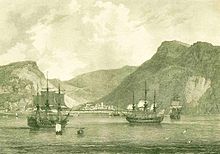Jamestown, Saint Helena
Many of the buildings built by the East India Company in the 18th century survive and give the town its distinctive Georgian flavour.
The city briefly hosted Napoleon in 1815 during his exile on St. Helena and later served as a base for the Royal Navy's efforts to suppress the slave trade.
[2] After his defeat in the Battle of Waterloo in June 1815 and the subsequent occupation of Paris, the Emperor of the French, Napoleon, surrendered to the British and was exiled to St Helena.
He arrived on 21 October aboard the 74-gun ship HMS Bellerophon and resided at the Briars in Jamestown for several months until he was transferred to Longwood House in a more remote part of the island in December.
[4] Jamestown was chosen to host a vice admiralty court and a naval base for British efforts to stop the slave traffic between Africa and the Americas.
Captured slave ships were often brought to Jamestown to be sold and their cargos were off-loaded in Rupert's Valley.
By the time that the naval station was closed in the 1870s, an estimated 25,000 slaves had been rescued, although about 5,000 died shortly after arrival and were buried in Rupert's Valley.
The oil tanker RFA Darkdale was sunk by the German submarine U-68 in James Bay on 22 October 1941 with only nine of the 50-man crew surviving.
It houses much of the island's infrastructure, such as its power station and associated fuel storage, and a one-ship wharf was completed in June 2016.
While Jamestown receives less than 5 inches (13 cm) of rainfall per year, the higher parts of the island are also wetter than the city, which lies on the drier coast and in a sheltered location.
[19] The city's population has been shrinking and it is no longer the largest settlement on the island, having been surpassed by Half Tree Hollow, Saint Paul's and Longwood.




